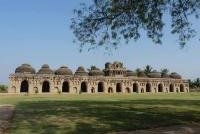
If you are liable to get “Templed out” by a surfeit of historic ruins it could happen to you here! The site consists of the monumental remains of an entire city from the 14th century covering some 25 sq kms and takes at least a full day to achieve a reasonably “comprehensive” visit. Some will want to stay several days but 1 was enough for us – you will know how “fast” you like to travel! A few of the structures are of particular architectural/artistic significance but I guess what makes the site “special” is its location within a striking boulder-strewn landscape and a very relaxed uncrowded atmosphere. It appears to be something of an R+R destination among the back-packer community and I can imagine people all over India agreeing to meet up at the Mango Tree restaurant – we felt very old there! It is also within reach of package tour overnighters from Goa, but the place seems big enough to take them all. And yes, we found it a worthwhile visit, if not of the most memorable of our Indian WHS.
You will need to consider how you are going to cover these distances – are you comfortable walking in the sun or do you want to rent a bike/motor bike etc. Some slightly incongruous electric vehicles have recently been acquired by the management authority to transport tourists to/from the Vitthala Temple but, to us, only seemed geared to taking them to/from their car park!! We had a car but there was still quite a lot of walking and, in retrospect, we perhaps dallied too long over our breakfast in Hospet, some 10 kms away. There is a premium on getting to the site early before the heat of the day!! If you only have a day and “completeness” is important to you then a bit of planning is worthwhile – and possibly even having a guide (who can also help with the meaning of all those Hindu carvings!). Having started at around 9.30 we were rushing to get into the Queens Baths as they closed at 5pm! There are at least 5 main temple complexes plus some significant other buildings such as the Elephant stables (photo) to fit in.
Most of the site is “free to enter” but you will need to pay the R250 foreigners entry fee to get into the highlight temple complexes. The operational Virupaksha temple also has its own separate entry fee. As well as the monumental structures there are remains of several covered markets and one has become ”Hampi Bazaar” where people live and operate small guest houses, restaurants, tourist shops etc – it has an interesting photographic museum with old pictures of Hampi. Some restoration has taken place since those days but many of the structures still seem in considerable need of some TLC. The main temple within the “highlight” Vitthala complex was “closed” for restoration – or rather possibly to prevent bits falling onto tourists as nothing much seemed to be happening. Other buildings were supported from behind by ugly breeze-block buttresses and the revolving wheels on the iconic “Chariot” had been cemented to prevent further damage by tourists. Hampi was on the “In Danger” list from 1999-2006 but mainly because of plans to build bridges over the river and unsuitable development within the area - particularly at Hampi Bazaar. The Monitoring Report of 2007 seemed remarkably relaxed about the state of the structures themselves and concentrated on the Management Plan, the new shuttle bus service etc.
More on
Comments
No comments yet.
